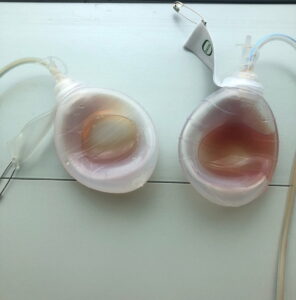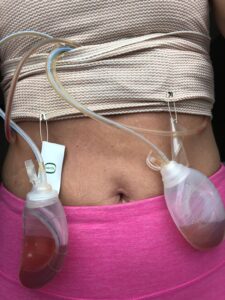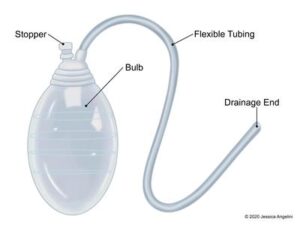Dr. Horton’s Breast Augmentation Journey Part VII – “BYOD”: Bring Your Own Drains

I am a firm believer in surgical drains after breast augmentation. So much so, that I brought my OWN drains to my breast augmentation surgery (“BYOD” = bring your own drains). 😉

I’m right handed, so it was no surprise that my right drain put out more fluid and was slightly darker than the left side.
During breast augmentation surgery, regardless of whether the implant is subglandular (on top of the muscle) or subpectoral/dual plane (completely or partially under the pectoralis major muscle), a pocket is created for the implant. When you have a wound, your body secretes fluid from the raw wound surface, similar to when you deeply scrape your skin. In the instance of a wound outside the body, you first bleed, then your body secretes a clear yellow fluid known as wound fluid or “serous fluid”, then it dries and you form a scab.

We use soft, supple “channel” drains that are attached to a “JP bulb” to gently and gradually whisk away wound fluid after breast implant surgery or tummy tucks.
Inside the body however, wound fluid accumulates in its closed space – such as around a breast implant or under abdominal skin as in an abdominoplasty (tummy tuck). Wound fluid is filled with lots of proteins and sugars ,and is an excellent medium for bacterial growth. By whisking away this wound fluid with drains, there is much less surgical swelling (your body does not need to absorb retained wound fluid over weeks or months), there is less risk of postoperative infection and in turn capsular contracture, and you can appreciate your final results sooner (within weeks)!
After my breast augmentation surgery, I milked my drains several times daily and emptied them twice a day. See the video above to watch me do it! Since I didn’t have a great amount of breast tissue preoperatively (if you have more fat, you tend to produce more fluid), and since my implants were not under the muscle, I didn’t drain much.
“Your drains tell on you” is what I warn my patients when they have drains. I noticed that my right drain fluid was slightly bloodier and put out more fluid than the left for the first two days. I’m right handed, and that was expected.
After surgery, I walked around town for the next couple of days with my drain bulbs in my pockets (Was anyone noticing my drains? NO!). I took prophylactic (preventative) antibiotics as prescribed, no more Ativan and only one narcotic pain pill. I was fine on extra strength Tylenol after that. Subglandular implants (not under the muscle) are not very painful – I can testify to that!
I unwrapped and rewrapped my dressing and Mary helped me wash my hair in the tub on postop day 2. It felt good to get clean, as I normally wash my hair every day and I showered the bottom half of my body.
Drains go through a natural evolution in color and consistency. Being a bartender, I can’t help but describe them as the following:
- Bloody Mary
- Cabernet sauvignon
- Merlot
- Pinot noir
- Rosé or Ice wine
- Chardonnary
- Pinot Grigio
The drain tubes can be a little irritating against the skin. Padding the skin underneath with a soft pad like a makeup remover pad or piece of a pantiliner is helpful, as shown in this video:
My drains were removed on postop day 3, as is common. They didn’t hurt when they came out, it just felt weird. I was happy to have passed this milestone and was excited to return home to my family!
